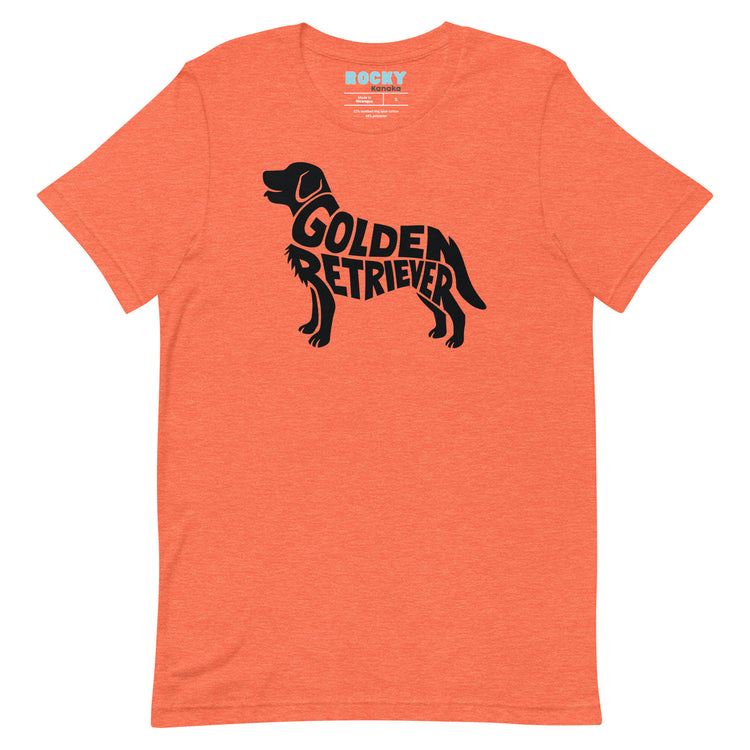This Golden Retriever Service Dog’s Disney Moment Will Melt Your Heart
Everyone dreams of giving their dog the royal treatment—spoiling them with belly rubs, treats, and endless snuggles. We even plan pet-friendly getaways so they can join the fun. But every now and then, a lucky pup gets an experience that’s truly unforgettable. (Watch Video Above)
Meet the Star: Nala the Service Dog
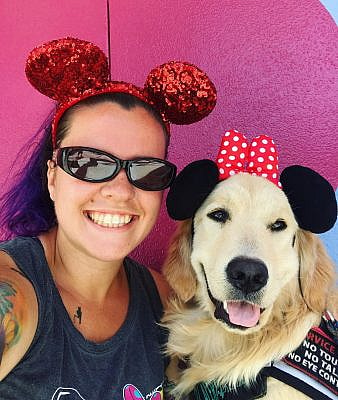
Nala is a gorgeous golden retriever and the service dog to her mom, Megan Leigh.
In addition to being super adorable, Nala performs essential services. She can pick up items, open doors, and provide crucial support to her mom.
Nala & Donald

While Nala has always had a special place in her mom’s heart (as all dogs do), she rose to public attention in a recent viral video of her adventures at Disney World. While visiting Epcot’s world showcase, Nala and Meg took a bit of a detour to visit Donald Duck.
The connection was immediate. Nala took to the feathered fiend like a tick! With love in her eyes and a wagging tail, she rolled around in Donald’s lap and enjoyed his affectionate belly rubs. This viral video has wormed its way into the hearts of many and made Nala an internet superstar.

With Meg’s help, Nala has created a delightful presence for herself online. Her Instagram account, HelperDogNala, showcases her enduring love for all things Disney. She’s had many visits to the park since her iconic meet-and-greet with Donald, and she’s even made some new friends! It seems that many of the cast members—including Pluto, Toy Story’s Green Army Men, and a few princesses—have joined Nala’s fan club.
On a personal level, Nala’s welcomed a new member into her family. She now serves as the mentor to Zazu, a service dog in training. With their help, Meg has enjoyed multiple wonderful visits to the Disney parks.

What Nala Wants You to Know About Service Dogs
But Nala isn’t just a Disney fan. She’s also a working dog. For Nala, this means providing physical support and keeping a watchful eye over her mom. Zazu, meanwhile, is actively training to be just like Nala.
As service dogs, both Nala and Zazu are allowed into far more places than regular dogs. They are legally protected and can accompany Meg into restaurants, theaters, and (of course) theme parks. This isn’t some sort of special perk, though. It’s part of their job. It also sets them apart from emotional support animals, who may or may not be allowed into different venues at the owner’s discretion.
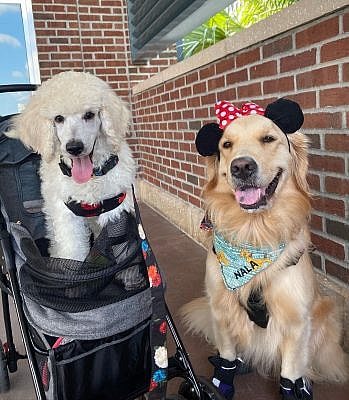
What is a Service Dog?
So, what is a service dog? A service dog is a working pet. Depending on the individual owner’s needs, service dogs can do a variety of different tasks. While many service dogs have overlapping skill sets and may serve multiple roles, the job of a service animal is broken down into a few basic categories:
- Guide dogs assist visually impaired owners.
- Hearing dogs assist hearing-impaired owners.
- Mobility dogs provide physical support by picking up items, pressing buttons, opening doors, and so on.
- Psychiatric support dogs share a role with emotional support animals, though their duties are often more specific.
- Medical alert dogs keep watch and alert owners when they sense an impending emergency, such as a seizure or diabetic attack.
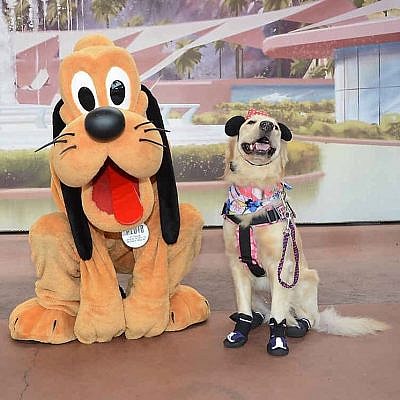
The Difference Between Service Dogs and Emotional Support Animals
Under the Americans with Disabilities Act (ADA), service dogs are classified as working animals, not pets. This means that they are allowed into areas where pets are not. For instance, you can’t take your standard dog into a restaurant, but a service dog is legally required to be permitted entry.
This isn’t to be taken lightly or to be used as some sneaky workaround to get your puppy to rest under the table at California Pizza Kitchen. Service dogs provide legitimate and essential support for their owners. These pups are highly trained to be calm under pressure, even in loud and chaotic situations. Emotional support animals, however, often have less rigorous training. Moreover, they are not protected under the same legal framework.
In the simplest sense, a service dog is unique in its training. While emotional support animals and therapy dogs are able to provide comfort to many, a service dog is specifically trained to help a singular individual.
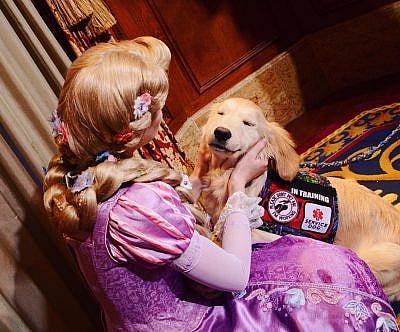
Where Do Service Dogs Come From?
The most common avenue for obtaining a service dog is through a certified trainer. These expert handlers raise their dogs from puppies and begin training immediately. These are highly specialized animals whose disposition, determination, and willingness to please have set them above the rest. In fact, standards are so high among professional trainers that anywhere from 50–75% of pups become regular pets.
After training these dogs, the trainers will do the paperwork and handle the fees required to legally recognize their pups as working dogs. All of this work is ultimately passed onto the client. While there are plenty of nonprofit service dog training organizations, private for-profit ventures will charge around $25,000 for a service dog.
The Fake Service Dog Problem
While legitimate service dogs come with their own legal paperwork, it’s disturbingly easy to purchase a service dog vest online. With these, some unscrupulous individuals force their poorly trained pooches into public venues, which ultimately harms and undermines the legitimacy of true service dogs.
You can help! Keep others educated. You don’t need to demand papers from every service dog owner; the behavior of a true service dog is easy to spot. As opposed to the fake service dogs, true service animals exhibit a few key traits:
- Extreme focus, even in overwhelming situations
- Keen obedience skills
- The ability to perform complex tasks, such as pressing buttons or opening doors
- Obedience far above what a standard dog would know
- Knowledge of complex commands
Moreover, remember that a service dog is a service dog. Therapy dogs and emotional support animals do not qualify for any of the protections offered to a service dog.
How are Service Dogs Trained?
Because of the rigorous training service dogs are required to undergo, many dogs simply don’t make the cut. There are a handful of breeds whose loyalty and intelligence set them apart, which is why they are most commonly seen as service animals. These breeds include: German shepherds
-Golden retrievers
-Labradors
-Poodles
Though many will opt to acquire pre-certified service dogs from professional trainers, it’s possible to train your own. However, it’s not a simple process. Service dogs must be able to handle loud and chaotic situations without being interrupted. In addition to standard basics, such as simple commands, service dogs will also need to be repeatedly exposed to situations where they’ll need to provide support.
However, it’s not a simple process. Service dogs must be able to handle loud and chaotic situations without being interrupted. In addition to standard basics, such as simple commands, service dogs will also need to be repeatedly exposed to situations where they’ll need to provide support.
What is a service dog?
A service dog is a trained animal, typically a dog, that assists individuals with disabilities or medical conditions, helping them perform tasks they cannot do on their own.
How is a service dog different from a therapy or emotional support dog?
While all three types of dogs provide support, service dogs are specifically trained to perform tasks for individuals with disabilities. Therapy dogs provide comfort in therapeutic settings, and emotional support dogs offer emotional support but aren’t trained for specific tasks.
How can I get a service dog?
To get a service dog, you typically need a recommendation from a healthcare provider. Once you have that, you can approach service dog training organizations or trainers to find a suitable dog.
Do service dogs need to wear a vest or badge?
No, service dogs are not legally required to wear a vest or badge. However, many handlers choose to have their dogs wear them to indicate their status and avoid unnecessary questions.
Are there specific breeds that make the best service dogs?
While breeds like Golden Retrievers, Labradors, and German Shepherds are popular choices due to their trainability and temperament, any breed can be a service dog as long as it can perform the required tasks.
Can service dogs go anywhere with their handlers?
Yes, under the Americans with Disabilities Act (ADA), service dogs are allowed to accompany their handlers in most public places, including restaurants, hotels, and stores.
Do service dogs ever get time to “just be dogs”?
Absolutely! While they are trained to work and assist their handlers, service dogs also get time to relax, play, and engage in regular dog activities.
How are service dogs trained?
Service dogs undergo rigorous training, often starting as puppies. They are trained to perform specific tasks, behave appropriately in public settings, and not be distracted by their surroundings.
Can I pet or interact with someone’s service dog?
It’s essential to always ask the handler before interacting with a service dog. Distractions can prevent the dog from performing its tasks, which can be dangerous for the handler.

